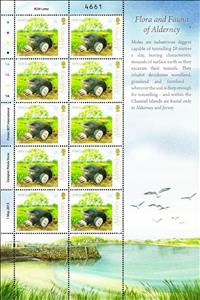Mini Sheet: Mole (Talpa europaea) (Alderney 2015)
Mole (Talpa europaea) (Alderney 2015)
01 May (Alderney ) within release Alderney Flora and Fauna goes into circulation Mini Sheet Mole (Talpa europaea) face value RoW No Face Value
| Mini Sheet Mole (Talpa europaea) in catalogues | |
|---|---|
| Michel: | Mi: GG-AL 531KB |
Mini Sheet is vertical format.
Also in the issue Alderney Flora and Fauna:
- Stamp - Sea Lavander face value local;
- Stamp - Blonde Hedgehog (Erinaceus europaeus) face value Local Large;
- Stamp - Dwarf Thistle face value UK;
- Stamp - Black Rabbit (Oryctolagus cuniculus forma domestica) face value EUR;
- Stamp - Spotted Rock-Rose face value UK LARGE;
- Stamp - Mole (Talpa europaea) face value RoW;
- Souvenir Sheet - Flora and Fauna face value None;
- Mini Sheet - Sea Lavander face value 10*Local;
- Mini Sheet - Spotted Rock-Rose face value UK;
- Mini Sheet - Dwarf Thistle face value UK;
- Mini Sheet - Black Rabbit (Oryctolagus cuniculus forma domestica) face value 10*EUR;
- Mini Sheet - Mole (Talpa europaea) face value RoW;
- Mini Sheet - Blonde Hedgehog (Erinaceus europaeus) face value 10*Local;
Mini Sheet Mole (Talpa europaea) it reflects the thematic directions:
Animals are multicellular, eukaryotic organisms of the kingdom Animalia (also called Metazoa). All animals are motile, meaning they can move spontaneously and independently, at some point in their lives. Their body plan eventually becomes fixed as they develop, although some undergo a process of metamorphosis later on in their lives. All animals are heterotrophs: they must ingest other organisms or their products for sustenance.
Mammals are any vertebrates within the class Mammalia (/məˈmeɪli.ə/ from Latin mamma "breast"), a clade of endothermic amniotes distinguished from reptiles (including birds) by the possession of a neocortex (a region of the brain), hair, three middle ear bones and mammary glands. All female mammals nurse their young with milk, secreted from the mammary glands. Mammals include the largest animals on the planet, the great whales. The basic body type is a terrestrial quadruped, but some mammals are adapted for life at sea, in the air, in trees, underground or on two legs. The largest group of mammals, the placentals, have a placenta, which enables the feeding of the fetus during gestation. Mammals range in size from the 30–40 mm (1.2–1.6 in) bumblebee bat to the 30-meter (98 ft) blue whale. With the exception of the five species of monotreme (egg-laying mammals), all modern mammals give birth to live young. Most mammals, including the six most species-rich orders, belong to the placental group. The largest orders are the rodents, bats and Soricomorpha (shrews and allies). The next three biggest orders, depending on the biological classification scheme used, are the Primates (apes and monkeys), the Cetartiodactyla (whales and even-toed ungulates), and the Carnivora (cats, dogs, seals, and allies).
The mole (symbol mol) is a unit of measurement, the base unit in the International System of Units (SI) for amount of substance, an SI base quantity proportional to the number of elementary entities of a substance. One mole is an aggregate of exactly 6.02214076×1023 elementary entities (approximately 602 sextillion or 602 billion times a trillion), which can be atoms, molecules, ions, ion pairs, or other particles. The number of particles in a mole is the Avogadro number (symbol N0) and the numerical value of the Avogadro constant (symbol NA) expressed in mol-1. The value was chosen on the basis of the historical definition of the mole as the amount of substance that corresponds to the number of atoms in 12 grams of 12C, which made the mass of a mole of a compound expressed in grams, numerically equal to the average molecular mass or formula mass of the compound expressed in daltons. With the 2019 revision of the SI, the numerical equivalence is now only approximate but may be assumed for all practical purposes.


